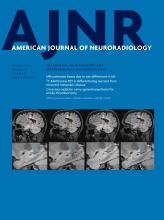Abstract
BACKGROUND AND PURPOSE: Branch atheromatous disease is a stroke subtype considered a risk factor for early neurologic deterioration. Meanwhile, crossed cerebellar diaschisis is thought to be influenced by the degree and location of supratentorial perfusion abnormalities and is associated with the clinical outcome in the case of an ischemic stroke. In this article, our aim was to clarify the utility of using a whole-brain 3D pulsed continuous arterial spin-labeling method as an imaging biomarker for predicting neurologic severity in branch atheromatous disease.
MATERIALS AND METHODS: Twenty-three patients with branch atheromatous disease in the lenticulostriate artery territory were enrolled. All patients underwent MR imaging, including DWI, 3D-TOF-MRA, and 3D-arterial spin-labeling. We measured the asymmetry index of CBF in the affected area (branch atheromatous disease), the asymmetry index of the contralateral cerebellar hemisphere (crossed cerebellar diaschisis), and the DWI infarct volume in the lenticulostriate artery territory. We also compared each parameter with the initial NIHSS score with the Pearson correlation coefficient.
RESULTS: Among the 23 patients, we found no correlation between NIHSS score and the asymmetry index of CBF in the affected area (branch atheromatous disease) (r = −0.027, P = .724), whereas the asymmetry index of the contralateral cerebellar hemisphere (crossed cerebellar diaschisis) and DWI infarct volumes were significantly correlated with NIHSS score (r = 0.515, P = .012; r = 0.664, P = .001, respectively).
CONCLUSIONS: In patients with branch atheromatous disease, 3D-arterial spin-labeling can detect crossed cerebellar diaschisis, which is correlated with the degree of neurologic severity.
ABBREVIATIONS:
- AIBAD
- asymmetry index of the affected area (branch atheromatous disease)
- AICCD
- asymmetry index of the contralateral cerebellar hemisphere (crossed cerebellar diaschisis)
- ASL
- arterial spin-labeling
- BAD
- branch atheromatous disease
- CCD
- crossed cerebellar diaschisis
- END
- early neurologic deterioration
- LSA
- lenticulostriate artery
- ref
- reference
- © 2017 by American Journal of Neuroradiology












